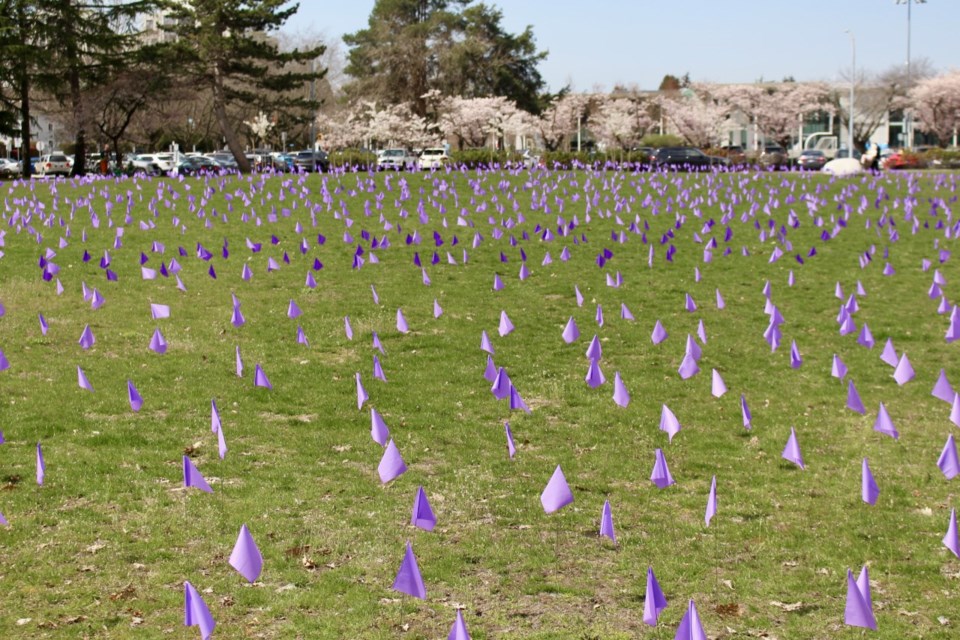It’s a pretty sight: a field of small purple flags standing a foot off the ground, it looks a bit like a meadow of lupine.
Too bad every one of those 2,272 purple flags represents the ugly reality of addiction and drug poisoning.
Last Friday a group of heartbroken family members and their supporters gathered in front of the Brighouse library to mark the seventh anniversary since the provincial government declared deaths due to opioid use a public health emergency.
Since then, an additional 11,171 men, women and children have been killed, some say murdered, in B.C. as a result of this toxic plague.
We used to call these deaths drug overdoses, but that implies a user decided to take more than they should have, like someone on a drinking binge.
That may have been the case for some, but many were taking exactly what they normally take. They just didn’t realize their supply was laced with, oh let’s say, an elephant tranquilizer.
In other words, the user didn’t overdose any more than if the beer they were drinking was spiked with arsenic.
But whatever we call it, the death toll has surpassed pandemic proportions. B.C. has seen 5,371 deaths related to COVID-19. In that same time, more than 7,000 people have died due to drug toxicity.
But what do those numbers really tell us? For those folks whose lives have not been touched by the opioid crisis (although those folks are getting harder to find) perhaps they are just numbers, a running tally or pack of statistics.
But for those of us who have been touched, each number is a beloved son, a funny brother, a devoted dad, a hard-working sister. They’re also aspiring artists, valued employees, tireless volunteers. They are construction workers, sex workers, journalists, medical professionals, drug dealers and street people.
As is always the case on one of these grim anniversaries, politicians and community leaders take to the airwaves and podiums to offer their condolences and, if they are in power, tell us what they’re doing to combat the problem or, if they’re in opposition, tell us what’s not being done to combat the problem.
What makes this hard to hear is the sameness of it all. It’s a bit like politicians down south trying to come up with something original to say after yet another mass shooting.
Everyone feels sorry, everyone knows help is needed, everyone knows something needs to change, yet around we go on this morbid merry-go-round.
The media is no better. We report on Friday’s rally, put it on the front page, write a column and move on.
However, last summer when one of our reporters lost her son to a toxic drug supply, we thought we had to do better. We convened a core working group to think of how we could report on this crisis in a way that could make change. We’re working on it, stay tuned.
When it comes to solutions, it appears there are two main roadblocks: money and morals, and they can be one in the same.
About the first, you might think that, as sad as the whole situation is, as a society we’re just not willing to put out the cash. But the ironic fact is we don’t have to.
Those who crunch the numbers repeatedly tell us that providing wrap-around supports to people with addictions — everything from housing to therapy — costs a fraction of what we’re spending now on policing and hospitalizing those same folks.
So, if we can’t get our heads around the economics of it, let’s try the morals.
I suspect many are holding onto a deep seated-value system that views addiction as a moral failing. It’s a value system politicians are well aware of, even if some don’t hold it themselves.
Despite the fact B.C.’s top medical professionals say addiction is a mental health issue for which users should be prescribed medication, there’s a far larger contingent of voters who worry that providing safe drugs sends a message to young people in particular that doing drugs isn’t that bad.
Maybe, but maybe the message we should be listening to is from the many people, young and old, those purple flags represent — drug use can be a brutal habit, but it’s our response that is criminal.



